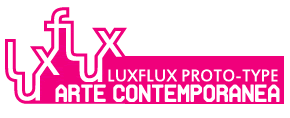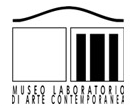Josip Broz Tito’s nuclear bunker, built between 1953 and 1979 in Konjic, is being opened, and it will be used for the first time; for a contemporary art project, the Biennale Of Contemporary Art, D-O ARK Underground, D-O ARK. It is a rebirth, a response to they who, like Tudjiman and Milosevic, tried to eradicate the dream of peaceful coexistence embodied by Sarajevo, the capital of Bosnia Herzegovina, the iconic city of religious tolerance and coexistence between different ethnic groups. Back to square one then in Bosnia Herzegovina; the (2nd) Sarajevo Biennale of Contemporary Art is being reborn, based on the project of a group of intellectual philosophical journalists from Sarajevo and an idea by the internationally renowned Bosnian artist Jusuf Hadžifejzović. He achieved the opening of the Nuclear Bunker, built by Josip Broz Tito between 1953 and 1979, to house the 2011 Sarajevo Biennale of Contemporary Art. A military bunker, command and war operations centre, as well as protection for Tito and his family in case of an atomic war; 6,500 square meters, 12 connected blocks, 280 meters bellow a mountain in Konjic, able to withstand a 25 kiloton bomb, that cost four and a half billion dollars, never used…
A labyrinth of corridors, with residential areas, conference rooms, offices, strategy rooms, printing machines and a switchboard for telecommunications. The reopening of the site, which remained a secret until the end of the Nineties, takes us back in time, to before the time of the criminal war of destruction and genocide, planned by the ambitious, nationalist and racist, Slobodan Milosevic, Franjo Tudjiman and Co.
The Biennale of Contemporary Art promoted by Bosnia Herzegovina, was born thanks to the very input of the Sarajevo that was hugely tormented between 1992 and 1995, up until the Dayton Peace Agreement. The project presents itself with international, democratic and constructive ambitions, able to make the most of the inter-country and inter-federal ties that exist between the countries of the former Yugoslavia. Uninterrupted ties of intellectual friendship and exchange. Uninterrupted even in times of aggression, under the real-life, media and rhetorical bombardments, aimed at the destruction of the foundations of universal human values. For this reason, the project has received The Council of Europe Cultural Event Label (CECEL).
In the project for the Biennale it is written: “The bunker is presented intact, with all the signs and symbols of our old social, economic, political and ideological system. Many monuments, especially those that represented that recent political system, were destroyed during and the after the wars. ARK is therefore a unique exhibition space, in an untraditional frame for art, from both a psychological and intellectual point of view”.
For years, of course, along with Jusuf Hadžifejzović, a group has been working towards the cultural re-stitching of Bosnia Herzegovina, together with the other ex-Yugoslavian states, with, above all, a regard for the young generations, but also a permanent and never fallen international vision. They include: the philosopher Senadin Musabegovic; the writers and critics Nermina Zildzo and Asja Mandic; the director of youth programmes for national television Boris Síber; the creator of the ‘Depo Portal’ cultural news portal Jasmin Durakovic; the poet and writer Mirsad Catic Cuperak; the Italian art collector Lucia Pianto; as well as many artists and writers who were already well know at the beginning of the Nineties; and with the organizing coordination of Edo and Sandra Hozic.
The first internationally recognized artist to have been invited is Jannis Kounellis. There will be many others. But the most interesting thing is certain; democratic directors and intellectuals from every part of the former Yugoslavia have been invited to sit around the organization table.
If the Commissioners making the decisions will be Jusuf Hadžifejzović (artist) from Bosnia Herzegovina, Petar Cukovic (critic) from Montenegro, and Branislav Dimitrijevic (critic) from the Republic of Serbia, its outstanding partner will certainly be the Centre for Cultural Decontamination of Belgrade, created and directed by Borka Pavicevic and others at the start of the Nineties.
Borka Pavicevic began operating in the knowledge that the regime’s rhetoric was preparing Serbia for war. A place of dissent “that through the language of theatre”, he wrote in a recent interview, “fought the xenophobia with which the concept of the former Yugoslavia was being destroyed, and the legend that this had represented. We all know what happened, but we were also in the besieged Sarajevo, to keep a light alive that all those who were critical could see. We fought and we continue to do so.”
Persecuted under Milosevic, in 2004 he was awarded the prestigious international award for Peace and Culture by the Hiroshima Foundation. He continues his work for reconciliation and a democratic culture, even after the Serbian political restoration, which followed the assassination of the 2003 Prime Minister Zoran Dijndijc.
Its first European partner was the Museo Laboratorio di Arte Contemporanea (MLAC), the Research Centre of the University of Rome, directed by Simonetta Lux, which operates internationally in places of “transitional” culture and contemporary society.
Its associates in Bosnia Herzegovina are the Contemporary Art Museum of Banja Luka, the Contemporary Art Centre of Sarajevo (SCCA) and the Collegium Artisticum Gallery in Sarajevo.
An extensive network of Info Points (concerning artists, debates, artworks, works in progress, the communication of forums and conferences) is foreseen in all its Partner and Associate locations, but which will also cover all the capitals of partner countries (Serbia, Croatia and Slovenia) as well as Europe.
In the meantime, Jusuf Hadžifejzović cultivates his fabric of creative ties and projects, like the one already underway at a Sub-Dokumenta “Charlama Project” in Sarajevo. Inviting young and established, national and international artists to exhibit in the unused spaces of the large Skenderijia shopping centre of Sarajevo, made available to them by the owner.
A certain excellent, unexpected, image of Bosnia Herzegovina and of Sarajevo presents and constructs itself in this way, towards a Europe that is still too indifferent and distracted.
But why not reread the many excellent texts, like Il tunnel di Sarajevo, Il conflitto in Bosnia-Erzegovina: una guerra psichiatrica, edited by Angelo Lallo and Lorenzo Torresini (2004).
Welcome then.
– – – – –
Simonetta Lux is professor of Contemporary Art History at La Sapienza University of Rome and director of the MLAC (Museo Laboratorio di Arte Contemporanea) Research Centre of La Sapienza University. Moreover, she is the coordinator of a Research and Transitional Studies team (Cuba, Senegal and the former Yugoslavia) and was invited, on the 14th and 15th of December 2009, to the Forum on the realization of the Biennale Of Contemporary Art, D-O ARK Underground, D-O ART (Sarajevo, Bosnia Herzegovina), as well as to the opening of the Konjic Nuclear bunker, which will be the first location of an exhibition of the Biennale (scheduled for 2011). The MLAC of La Sapienza will be one of the international partners. Simonetta Lux has published Arte Ipercontemporanea. Un certo loro sguardo….(Gangemi, 2007/2008).
Jusuf Hadžifejzović, born 1956, is an internationally renowned artist from Bosnia Herzegovina, an icon of independent and democratic artistic research. Dual nationality, Belgian and Bosnian, who has studied internationally, he is a pacifist and was welcomed by the Belgian intelligentsia during the criminal war and genocide created by Slobodan Milosevic (1992-1995). He has exhibited in national and international museums and galleries (Vienna, Amsterdam, Rome, etc.). He represented Bosnia Herzegovina at the 2003 Venice Biennale. He works together with many other intellectuals, newspaper editors, philosophers and artists of the former Yugoslavia, who were already well known internationally before 1992 and who never split, to reconstruct a sense of democratic, political and cultural belonging and tolerance in the new generations (the philosopher Senadin Musabegovic, Jasmin Durakovic of the cultural news portal Depo Portal, the director of the National television’s youth programmes Boris Síber, as well as many artists and critics). A fabric of creative ties and projects, already underway in the form of a Sub-Dokumenta “Charlama Project” in Sarajevo, which invites young and established national and international artists, to exhibit in the unoccupied spaces made available to them by the owner of the large Skenderijia shopping centre of Sarajevo.
It was his idea and he requested that the Home Office open Tito’s never used Nuclear Bunker, built between 1953 and 1979, to the public and for cultural use, and to be used as the first international step for the upcoming second Sarajevo International Art Biennale (2011).
He recently exhibited in Rome as part of the Hyper-contemporary Art cycle, curated by Simonetta Lux and Domenico Scudero.
Depotgraphia Roma, installations, 2009, at the MLAC Sapienza, Rome (© photo Claudio Abate), and the demonstration performances, Life is Life for Günter Paul. The first performance took place at the MACRO, Rome, c/o MLAC (© photo Claudio Abate), and the final one in La Sapienza’s Great Hall, on closing day, underneath the 1935 fresco by Mario Sironi (L’Italia tra le Arti e le Scienze).
A Masterclass was also held, for Doctoral students of Art History and students of the Masters for Contemporary Art Curators of La Sapienza University of Rome, on the project for the democratic artistic cultural rebirth in Bosnia Herzegovina, promoted by Sarajevo.
Translation: Lincoln Dexter, Masters in Contemporary Art Curatorship
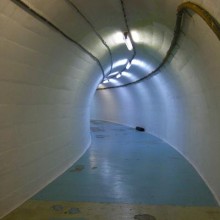
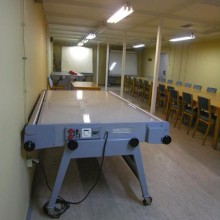
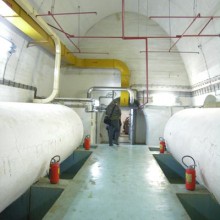
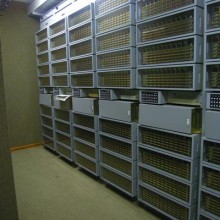
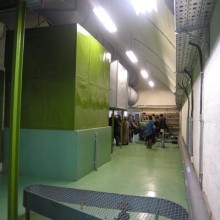
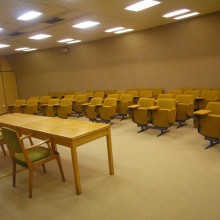
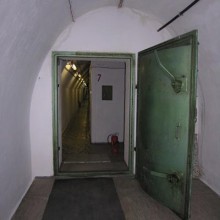

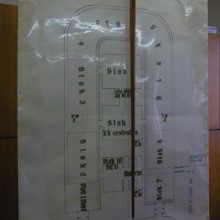

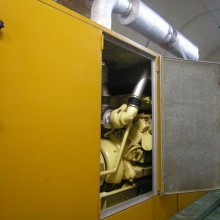
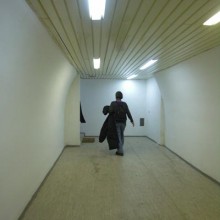
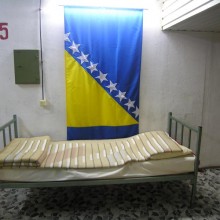
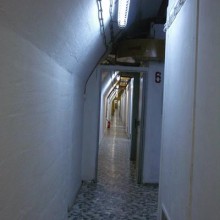
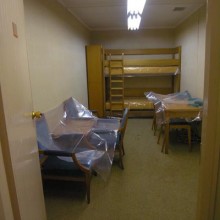
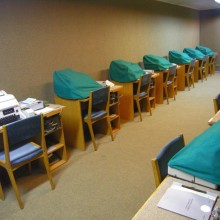
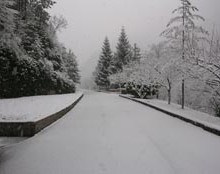
Tito’s nuclear bunker, Konjic (Sarajevo, Bosnia Herzegovina), 14 December 2009, photo Simonetta Lux
From the top:
Corridor in the U ring
Press and printing room;
Bunker, machinery
Bunker, telephone switchboard
Bunker, machinery
Bunker, conference room
Bunker, reinforced door
Bunker, tools
Map of the Bunker
Jusuf Hadzifejzovic
Ventilation system
Corridor leading to Tito’s apartment
One of the bedrooms
Office corridor
Interior furnishings
Telex room
Konjic, arrival at the Bunker
